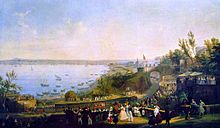art.wikisort.org - Artist
Salvatore Fergola (Naples, 24 April 1799 - Naples, 7 March 1874) was an Italian painter, mainly of landscapes or vedute in and around his native Naples. He is considered an exponent of the School of Posillipo.
This article may be expanded with text translated from the corresponding article in Italian. (January 2017) Click [show] for important translation instructions.
|


Biography
He was born in Naples. He was the son of the engraver of landscapes, Luigi Fergola and his wife, Teresa Conti. Salvatore was educated in literature and architecture. He became a follower of Jakob Philipp Hackert, who had also mentored his father. Like his father, and other painters such as Giacinto Gigante, he worked for some time in the Royal Topographic office. He was heavily patronized by the Bourbon Court;[1] for example, in 1819 the future Francesco I of the Two Sicilies commissioned views of Naples, including Naples from Capodimonte, Naples from Marinella, Naples from Ponte della Maddalena, a Veduta of the Botanical Gardens.
In 1827, he was nominated honorary professor to the Royal Institute of Arts (Real Istituto di Belle Arti (now the Accademia di Belle Arti di Napoli). Among his pupils was Achille Vertunni,[2] Ignazio Lavagna, and Giuseppe Benassai.[3] He died in Naples in 1874.
He was often utilized to commemorate government works and events: for example:
- Inauguration of the first railway in Italy, the Naples–Portici line, (Museo di San Martino)
- Construction of the first iron suspension bridge in Italy (Ponte Real Ferdinando sul Garigliano).
- Construction of the Chapel in the Campo di Marte (Reggia di Caserta)
- Train station for line to Castellammare (1845) (Reggia di Caserta)
Also of note:
- Interior of Sala Tarsia
- Bridge over Garigliano (Palace of Capodimonte)
- Waterfall (Museo di San Martino)
- Cain persecuted by ire of God (1849) (Royal Palace of Naples)
- Cain and Abel (Avvocatura dello Stato, Naples)
Gesìr che placa la tempesta (Palace of Capodimonte)
- San Francesco di Paola in Prayer
- Christ in Gesthemane (1858) (Gallery of the Academy of Fine Arts of Naples)
- Rest during Flight to Egypt (Royal Palace of Naples)
Bibliography
- Nicola Spinosa; Leonardo Di Mauro (2002). Electa Napoli (ed.). Vedute napoletane del Settecento. Naples. ISBN 88-435-5620-7.
- Franco Carmelo Greco; Mariantonietta Picone Petrusa; Isabella Valente (1993). Tullio Pirontie (ed.). La pittura napoletana dell'Ottocento. Naples.
- Mariantonietta Picone Petrusa; Isabella Valente (1994). Casa Editrice Cromosema (ed.). L'album della Regina. Rome.
- Translated in part from Italian Wikipedia entry
References
- Napier, Lord Francis (1855). Notes on Modern Painting at Naples.. West Strand, London: John W. Parker and Son. pp. 86–90.
- History of modern Italian Art, by Ashton Rollins Willard, page 374
- Studio intorno la vita e le opere d'arte di Giuseppe Benassai by Gioacchino Ferro, page 45
External links
![]() Media related to Salvatore Fergola at Wikimedia Commons
Media related to Salvatore Fergola at Wikimedia Commons
На других языках
[de] Salvatore Fergola
Salvatore Fergola (* 24. April 1799 in Neapel, Parthenopäische Republik; † 7. März 1874 in Neapel, Königreich Italien) war ein italienischer Maler, der insbesondere für die Landschaftsdarstellungen rund um seine Heimatstadt Neapel bekannt ist. Als einer der wichtigsten Vertreter der Schule von Posillipo malte er seine Veduten in plein air und mit ständig wechselnden Lichtspielen.- [en] Salvatore Fergola
[fr] Salvatore Fergola
Salvatore Fergola, né le 24 avril 1799 à Naples, République parthénopéenne et mort le 7 mars 1874 dans la même ville, Royaume d'Italie, est un peintre italien, particulièrement connu pour les représentations de paysages autour de sa ville natale, Naples. L'un des plus importants représentants de l'école de Posillipo, il peint ses vedutes en plein air et avec des effets de lumière en constante évolution.[it] Salvatore Fergola
Salvatore Fergola (Napoli, 24 aprile 1796 – Napoli, 7 marzo 1874) è stato un pittore italiano, considerato uno degli esponenti più autorevoli della scuola di Posillipo.Другой контент может иметь иную лицензию. Перед использованием материалов сайта WikiSort.org внимательно изучите правила лицензирования конкретных элементов наполнения сайта.
WikiSort.org - проект по пересортировке и дополнению контента Википедии